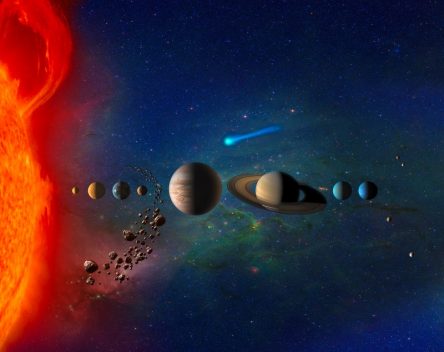
Cupid is up to his usual shenanigans on the 14th but I’m going to share with you some of my love for observing the moon and the planets with several dates in February. Don’t fret about needing a telescope to enjoy most of these sights, but a pair of regular old binoculars that you have lying about the house may be a useful supplement to your bare-naked eyeballs.
DATES TO REMEMBER
FEB 2 – A young crescent moon meets Jupiter in the early evening
Feb 7 – The crescent moon hangs out with the ice giant, Uranus
Feb 9 – Venus is at its brightest
Feb 25 & 26 – Bright Venus is near the waning crescent moon. BONUS: the moon also appears near the deep sky star forming factory, Messier 8 on the morning of the 25th.
Feb 27 – The thin waning crescent moon forms a lovely conjunction with Venus and Mars
WHAT YOU ARE SEEING
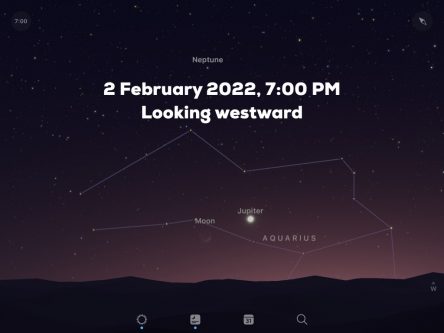 Jupiter, the largest planet in the solar system, has been a familiar presence in our evening sky since August of 2021 but by the month’s end it leaves the scene, becomes a morning object, and reappears to the evening sky in September of this year. On February 2nd, step outside around 30 minutes after sunset and face westwards to see it very low in the sky. With a pair of binoculars or a small telescope, see how many of the planet’s four largest moons (Jupiter has a total of 79 known moons) are visible: Io, Europa, Ganymede, and Callisto (I’ve listed them in their order of distance from the planet, innermost to outermost). Sky & Telescope offers an app called, appropriately enough, “Jupiters Moons” that will show you where they are within their orbit around the planet at any given time, but there are some generalized stargazing apps that have that feature as well.
Jupiter, the largest planet in the solar system, has been a familiar presence in our evening sky since August of 2021 but by the month’s end it leaves the scene, becomes a morning object, and reappears to the evening sky in September of this year. On February 2nd, step outside around 30 minutes after sunset and face westwards to see it very low in the sky. With a pair of binoculars or a small telescope, see how many of the planet’s four largest moons (Jupiter has a total of 79 known moons) are visible: Io, Europa, Ganymede, and Callisto (I’ve listed them in their order of distance from the planet, innermost to outermost). Sky & Telescope offers an app called, appropriately enough, “Jupiters Moons” that will show you where they are within their orbit around the planet at any given time, but there are some generalized stargazing apps that have that feature as well.
If you do use binoculars this evening, be sure and scan the sky to Jupiter’s lower left at this time as you may see a 2-day old moon, around 5% illuminated. This can be a challenge to pull out of the murk when looking so low in the sky. If you are a member of an astronomy club, chances are that they are affiliated with the Astronomical League, an umbrella organization for amateur astronomy clubs that helps promote the hobby and hone observing skills by having participants complete various observing programs. One of these programs involves lunar observing with binoculars and seeing the 2-day old waxing crescent moon is on the checklist of observing challenges. If you are affiliated with the League, then upon successful completion of any of their observing programs, you get a certificate, a lovely pin, and the satisfaction of knowing that you have sharpened your observing skills as an astronomer. You can still complete any of their programs, but you cannot submit your observing logs and collect either pin or certificate unless you are affiliated with the League via membership within a participating astronomy club. Visit the League’s website here: https://www.astroleague.org Alternatively, check with your local astronomy club to see if they are affiliated with the League.
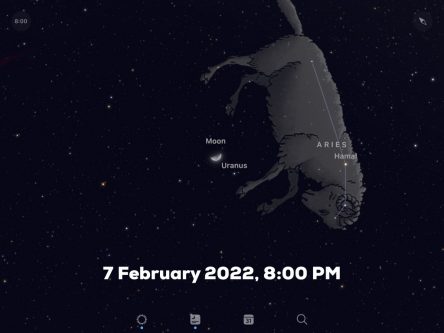 On the evening of the 7th, go outside and find the crescent moon while facing the SW. With a pair of binoculars or a small telescope, look just to the moon’s lower right to see a blue-green point. This is the planet Uranus. Uranus is the third largest planet in the solar system, with a diameter four times that of Earth’s. But it’s also some 1.8 billion miles away and, so, most people have not seen it. This pairing of the moon and Uranus will help you locate the ice giant world. Being so far away from the Sun, Uranus and Neptune are very much colder than the other planets and their atmospheres are laden with water ice and other icy compounds such as frozen ammonia. Therefore, we call them “ice giants”. Why are they so blue? Well, the ammonia in their atmospheres is very good at absorbing the redder portions of the Sun’s light while reflecting back the bluer portions and, so, Uranus and Neptune appear blue-green to our eyes.
On the evening of the 7th, go outside and find the crescent moon while facing the SW. With a pair of binoculars or a small telescope, look just to the moon’s lower right to see a blue-green point. This is the planet Uranus. Uranus is the third largest planet in the solar system, with a diameter four times that of Earth’s. But it’s also some 1.8 billion miles away and, so, most people have not seen it. This pairing of the moon and Uranus will help you locate the ice giant world. Being so far away from the Sun, Uranus and Neptune are very much colder than the other planets and their atmospheres are laden with water ice and other icy compounds such as frozen ammonia. Therefore, we call them “ice giants”. Why are they so blue? Well, the ammonia in their atmospheres is very good at absorbing the redder portions of the Sun’s light while reflecting back the bluer portions and, so, Uranus and Neptune appear blue-green to our eyes.
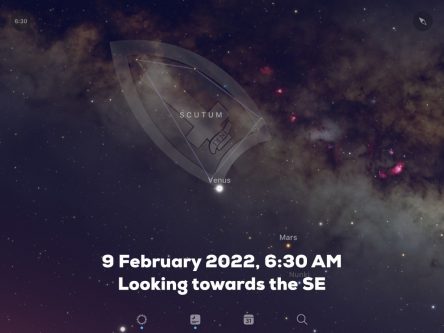 Venus, named for the Roman goddess of love and beauty, second planet from the Sun and our closest planetary neighbor (coming as close as 27 million miles to Earth but is, on average, about 31 million miles away) dropped out of our evening sky early last month and has now become our “Morning Star”. It will remain a morning planet until December of this year, when it will once again shine bright in the evening sky. On February 12th, Venus reaches its greatest illuminated extent, meaning that, seen through a telescope, the apparent size of its disc is at its largest. But here’s the kicker, Venus will only appear as a crescent. Whaaa? First off, yes, Venus goes through phases, just like the moon does. Mercury, the innermost planet, does to. Why? Well, as these two planets orbit inside Earth’s orbit, we see that their orbital positions, relative to the Sun and Earth, are constantly changing and, so, we see different areas of their surface becoming illuminated and then passing into shadow as they complete their laps around the Sun. If you have access to a small telescope (the NASA Arkansas Space Grant Consortium, based at UA Little Rock, has funded a number of libraries across the state, including the Central Arkansas Library System, with telescopes that patrons can check out just like a book), then be sure and train it on Venus in order to see its phase.
Venus, named for the Roman goddess of love and beauty, second planet from the Sun and our closest planetary neighbor (coming as close as 27 million miles to Earth but is, on average, about 31 million miles away) dropped out of our evening sky early last month and has now become our “Morning Star”. It will remain a morning planet until December of this year, when it will once again shine bright in the evening sky. On February 12th, Venus reaches its greatest illuminated extent, meaning that, seen through a telescope, the apparent size of its disc is at its largest. But here’s the kicker, Venus will only appear as a crescent. Whaaa? First off, yes, Venus goes through phases, just like the moon does. Mercury, the innermost planet, does to. Why? Well, as these two planets orbit inside Earth’s orbit, we see that their orbital positions, relative to the Sun and Earth, are constantly changing and, so, we see different areas of their surface becoming illuminated and then passing into shadow as they complete their laps around the Sun. If you have access to a small telescope (the NASA Arkansas Space Grant Consortium, based at UA Little Rock, has funded a number of libraries across the state, including the Central Arkansas Library System, with telescopes that patrons can check out just like a book), then be sure and train it on Venus in order to see its phase.
But, if it’s just a crescent, why is it so darn bright? There are a couple of reasons for this. You would think that it would be brightest at full phase, right? But that full phase (or, near full) only occurs when Venus is on the far side of the Sun, placing it very far away from Earth. At such a great distance, it doesn’t appear very bright. But, during a crescent phase, it is getting much closer to Earth and that makes the brightness factor really crank up. The other thing to remember about Venus’s brightness is the fact that the planet is entirely blanketed in clouds that are laced with liquid droplets and tiny crystals of sulfuric acid. The sulfuric acid droplets and crystals are very efficient when it comes to reflecting sunlight and that’s what makes Venus so dang bright. On the morning of the 9th, step outside and face east to see Venus shining at a magnitude of -4.6, it will not be this bright again in our sky until July of 2023. As a side note, when Venus is this bright, it is often reported as a UFO sighting.
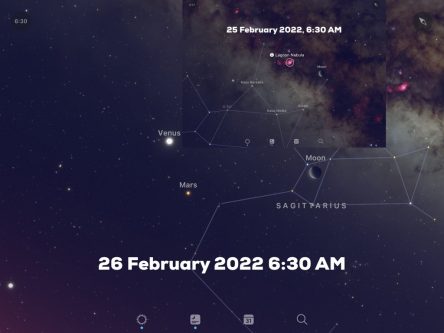 About an hour before sunrise on the mornings of February 25th and 26th, look towards the SE to see Venus, low in the sky, with a beautiful waning crescent moon off to the lower right. Once again, a pair of binoculars may prove useful for this particular observing opportunity. On the morning of the 25th, look to the left of the moon, using binoculars or a small telescope (and as dark a sky as you can find) and you just might see place where stars are being born. Known as Messier 8, or the Lagoon Nebula, this stellar nursery is located over 5,000 light-years away in the constellation of Sagittarius. In binoculars, you can see the nebula as a faintly glowing, fuzzy cloud; with a small telescope, you can begin to appreciate more of its intricate structure. The glow is created by the newborn stars energizing the gas in the cloud. The ultraviolet radiation the young stars emit gives an energy kick to the atoms of hydrogen that makes up the gas cloud. As the atoms return to their normal energy state, they emit a faint glow and that is what you are seeing in your binoculars or telescope. Our morning sky is a sneak preview of what we are going to see in our evening sky a few months hence. In summer, Sagittarius and Messier 8 are prominent in the evening sky and, on moonless nights, you can just barely see the nebula as a faint, glowing patch upon the sky (provided you are observing from a dark sky locale).
About an hour before sunrise on the mornings of February 25th and 26th, look towards the SE to see Venus, low in the sky, with a beautiful waning crescent moon off to the lower right. Once again, a pair of binoculars may prove useful for this particular observing opportunity. On the morning of the 25th, look to the left of the moon, using binoculars or a small telescope (and as dark a sky as you can find) and you just might see place where stars are being born. Known as Messier 8, or the Lagoon Nebula, this stellar nursery is located over 5,000 light-years away in the constellation of Sagittarius. In binoculars, you can see the nebula as a faintly glowing, fuzzy cloud; with a small telescope, you can begin to appreciate more of its intricate structure. The glow is created by the newborn stars energizing the gas in the cloud. The ultraviolet radiation the young stars emit gives an energy kick to the atoms of hydrogen that makes up the gas cloud. As the atoms return to their normal energy state, they emit a faint glow and that is what you are seeing in your binoculars or telescope. Our morning sky is a sneak preview of what we are going to see in our evening sky a few months hence. In summer, Sagittarius and Messier 8 are prominent in the evening sky and, on moonless nights, you can just barely see the nebula as a faint, glowing patch upon the sky (provided you are observing from a dark sky locale).
 Finally, on the morning of February 27th, check out a beautiful waning crescent moon just to the lower right of bright Venus. Mars, the fourth rock from the Sun, is fainter but can be found in between the two. Many of the newer smartphone models are equipped with cameras sensitive to image many of the things we’ve talked about here, including this one. If you own one, try it out, it can only help enhance your awe and wonder with the universe in which you live.
Finally, on the morning of February 27th, check out a beautiful waning crescent moon just to the lower right of bright Venus. Mars, the fourth rock from the Sun, is fainter but can be found in between the two. Many of the newer smartphone models are equipped with cameras sensitive to image many of the things we’ve talked about here, including this one. If you own one, try it out, it can only help enhance your awe and wonder with the universe in which you live.